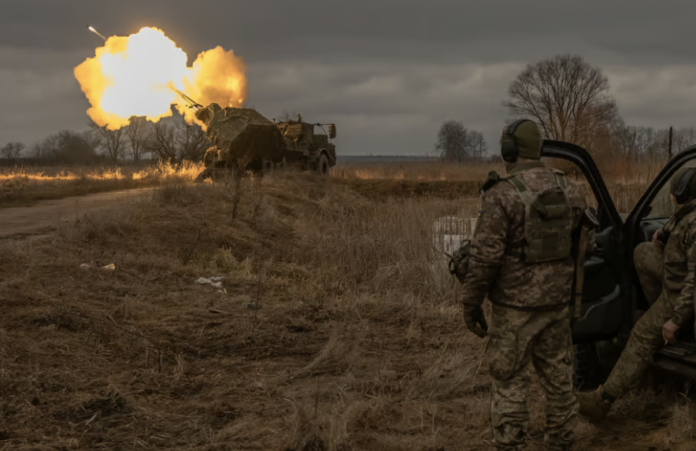This is the third year of the country's full -scale war with Russia and ten years after Moscow illegally annexed Crimea and initiated a conflict in eastern Ukraine. After despair from the first attack, and then the growing hopes for a quick turn, the facts on the forefront now indicate a year of stagnation.
Ukrainian soldiers are exhausted, and its armed forces lacks artillery ammunition and air defense missiles, while weapons, such as F-16 fighters and army tactical missile system MGM-140 production of the United States (ATACMS) have not yet been received.
This year will be the year "Restoration and preparation on both sides, as in 1916 and 1941-42 during the last world wars," said Mark TIS, who last year resigned from the post of Deputy Head of Defense of Belgium in the rank of Lieutenant General.
To evaluate the prospects for next year, Politico asked analysts, officers and military experts to express their vision of the war.
No one could provide an accurate road card for 2024, but everyone agreed that three fundamental factors would determine the trajectory of development of the next months. First, this spring is related to the justification of expectations, as Ukraine will not have equipment or personnel for a significant counter-offensive; Secondly, with the help of its allies, Russia has provided an advantage in artillery and, together with continuous terrestrial attacks, strikes Ukrainian positions; And third, without Western air defense and long-range missiles, as well as artillery shells in Kiev, it will be difficult to create a reliable stable defense.
"The year will be difficult, no one can predict from what direction Russia will go from and whether we will advance this year," said Taras Chmut, Ukrainian military analyst, sergeant of the Navy Marine Corps.
However, it is clear that Ukraine is in the background.
After many weeks of bloody battles this month, Russia has finally taken the fortress city of Avdiivka. Without stopping at the respiration, its military continued to attack other key Ukrainian support points and logistical nodes: a robot in Zaporizhzhia region, Kupyansk in Kharkiv and the time of Yar in Donetsk region.
"A critical factor is Ukraine's ability to create favorable defensive positions," Politico said on the conditions of anonymity, an acting German officer who followed the conflict.
Russia is able to step because it is of concern to the life of its troops. The Ukrainian military estimated that the capture of Avdiivka cost Russia 47,000 soldiers, while Andrey Morozov, a Russian pro -pro -blogger, who later committed suicide, wrote that the army had lost 16,000 people. President of Ukraine Volodymyr Zelensky estimated that Russia has lost seven people for every Ukrainian.
Adding to this ignoring its own losses, Russia was able to defeat Ukrainian defense with its artillery advantage.
Estimates of annual production and renewal of shells in Russia range from 1 million to 4.5 million. "This volume is much higher than the number of artillery ammunition at the disposal of Ukraine," the Estonia Ministry of Defense said.
On the contrary, Western countries are in a hurry to increase their own ammunition production, and the United States is planning to produce about 1 million shells annually by the end of 2025 from the pre -war 190,000.
Russia has also received assistance through the delivery of drones from Iran and almost a million shells from North Korea, and since the beginning of the year it has already used at least 24 North Korean ballistic missiles for attack on Ukraine, said Prosecutor General of Ukraine Andriy Kostin.
Meanwhile, Ukraine is not experiencing shells, which forces its troops on the forefront of shots and rely on unconventional technologies such as drones to hold back Russian attacks.
Kyiv tries to increase internal production, but progress is slow.
The promise of the EU to send a million shells by March; Only 300,000 may have been delivered.
The United States may have sent 2 million 155mm shells since the beginning of the war, but these deliveries have been exhausted through a political deadlock in Washington regarding Ukraine's military assistance.
During a telephone conversation on February 20, between the Head of the Ministry of Defense of Ukraine Rustem Umerov, military general Alexander Sirsky and US Secretary of Defense Lloyd Austin, Ukraine priorities for new weapons and equipment for the coming months were determined.
According to one of the participants of the call, who was given anonymity to discuss the conversation, requests reflect some important changes in how Ukrainians plan to fight this year, and indicate how the war has changed from the first days.
As usual, more air defense systems are headed, but instead of fighters or tanks, Kiev is looking for drones for surveillance and striking, and behind them are radio -electronic fighting systems to deafen Russian drones and ballistic missiles aimed at the Ukrainian front and civilian lines.
Justin Bronk, a senior researcher at the Royal Institute of the Joint Services of the Royal Institute, said that whether the event would be able to achieve the best results in the supply of Ukraine in the coming months will depend on whether he will be able to hold the position this year.
"Supporting the supply of ammunition [for land-air missiles] for the western air defense systems of Ukraine and the rest of the Soviet air defense systems will be a key task for Western partners in 2024," the Bronk said.
US intelligence claims that 315,000 Russian soldiers have been killed or injured since the start of hostilities, but the Kremlin continues to nourish the war with people.
Last year, Russian President Vladimir Putin stated that Russia has 617,000 military in Ukraine, and there will be even more. The Russian population is three times higher than the population of Ukraine, which allows Putin to avoid wider conscription and rely instead on contract troops and emptying the country's prisons to provide cannon meat.
"The flow of our people who are ready to protect the interests of the Motherland in their hands is not diminishing," Putin said during an annual press conference on December 14.
The Ukrainian army has 800 thousand people, more than a million in reserves. Efforts to increase the number by reducing the conscript age from 27 to 25 years - which would add to the army about 400,000 men - came across crazy resistance. However, Ukrainian generals need more people to be able to take away the exhausted soldiers from the front and create new parts of trained and resting troops.
Estonia's Defense Minister Anna Mikur said that this year "will be the year of strategic development and defense for both Ukraine and the Euro -Atlantic community - sometimes to create the necessary military and industrial base."
"By 2025, Ukraine can have enough skills and means to defeat Russia."
But Russia is a moving target that has transferred its economy to martial law and is now producing new tanks, planes, rockets and artillery, as well as robbing Soviet times in search of equipment and ammunition.
Another problem for Ukraine is to preserve faith.
Most Europeans support Kyiv, but the vast majority think it is losing war.
In Ukraine, 85 percent of the population still believes that their country will win, but fewer people can describe how this victory will look and when it happens, according to recent surveys.
Pessimism is largely explained by the fact that the supply of assistance has slowed in recent months.
The Ukrainian analyst Chmut says that much depends on whether Republican leaders in the US Congress will give up their opposition to the help package to Ukraine.
US Army Minister Christin Warmut stated that if Congress fails to adopt a bill on Ukraine, it will be "extremely unprofitable for Ukrainians, because this money will give them additional ammunition."
European countries are also slowly accelerating the production of weapons and ammunition - both for sending to Ukraine and for equipping their own forces after years of neglect.
But the mood against Ukraine is gloomy - as it was apparent at the Munich Conference on this month, where last year's dizzying optimism about successful counter -offensive was replaced by acidic pessimism.
However, for General Ben Hodges, a former US Army Commander in Europe - the fact that Ukraine retains viable defense and remains decisive, is a reason to be positive. ”
First, the F-16 fighters will start coming in the coming months, helping Ukraine fight for control of the sky. There are also signs that the US can send more ATCMS ballistic missiles, while Germany is under pressure to put its powerful winged Taurus missiles. Such weapons would allow Ukraine to strike the Russian logistical and aviation bases far beyond the front line, undermining its ability to continue the attack.
"Wait for a minute, this war has been going on for 10 years, Russia had all the benefits, and after 10 years they occupied only 18 percent of Ukraine," Hodges said. "They [lost] half a million of the military, the black naval fleet is getting worse every day, and the Air Force cannot gain an advantage in the air."
He needed, he explained, a clear obligation of Western leaders - not only to hold on to Ukraine as much as you want, but also to support it with a weapon necessary for the actual victory in the war.
"I think that Russia is actually worse than we think," Hodges said.


